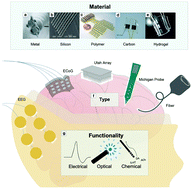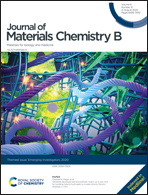Multimaterial and multifunctional neural interfaces: from surface-type and implantable electrodes to fiber-based devices
Abstract
Neural interfaces have enabled significant advancements in neuroscience and paved the way for clinical applications in the diagnosis, treatment, and prevention of neurological disorders. A variety of device modalities, such as electrical, chemical and optical neural interfacing, are required for the comprehensive monitoring and modulation of neural activity. The development of recent devices with multimodal functionalities has been driven by innovations in materials engineering, especially the utilization of organic soft materials such as polymers, carbon allotropes, and hydrogels. A transition from rigid to soft materials has improved device performance through enhanced biocompatibility and flexibility to realize stable long-term performance. This article provides a comprehensive review of a variety of neural probes ranging from surface-type and implantable electrodes to fiber-based devices. We also highlight the influence of materials on the development of these neural interfaces and their effects on device performance and lifetime.

- This article is part of the themed collection: Journal of Materials Chemistry B Emerging Investigators


 Please wait while we load your content...
Please wait while we load your content...